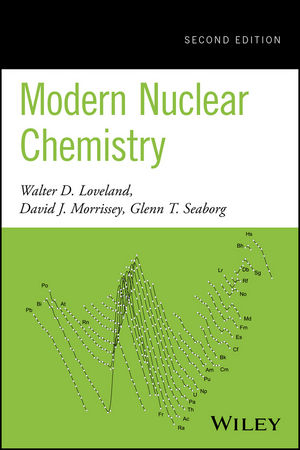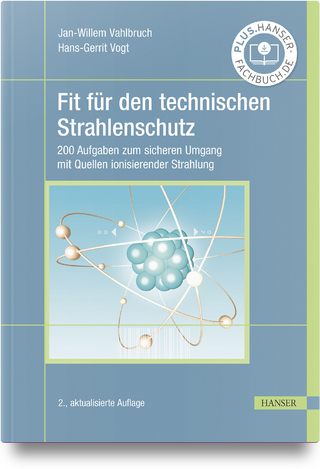
Modern Nuclear Chemistry
John Wiley & Sons Inc (Verlag)
9780470906736 (ISBN)
- Lieferbar (Termin unbekannt)
- Versandkostenfrei
- Auch auf Rechnung
- Artikel merken
Written by established experts in the field, this book features in-depth discussions of proven scientific principles, current trends, and applications of nuclear chemistry to the sciences and engineering.
• Provides up-to-date coverage of the latest research and examines the theoretical and practical aspects of nuclear and radiochemistry
• Presents the basic physical principles of nuclear and radiochemistry in a succinct fashion, requiring no basic knowledge of quantum mechanics
• Adds discussion of math tools and simulations to demonstrate various phenomena, new chapters on Nuclear Medicine, Nuclear Forensics and Particle Physics, and updates to all other chapters
• Includes additional in-chapter sample problems with solutions to help students
• Reviews of 1st edition: "... an authoritative, comprehensive but succinct, state-of-the-art textbook ...." (The Chemical Educator) and "...an excellent resource for libraries and laboratories supporting programs requiring familiarity with nuclear processes ..." (CHOICE)
WALTER D. LOVELAND, PhD, is a professor of chemistry at Oregon State University, USA. DAVID J. MORRISSEY, PhD, is a professor of chemistry and associate director of the National Superconducting Cyclotron Laboratory at Michigan State University, USA. GLENN T. SEABORG, PhD (deceased), was a professor of chemistry at the University of California, Berkeley, and cofounder and chairman of the Lawrence Hall of Science, USA. He is credited with discovering 10 new elements, including plutonium and one that now bears his name, seaborgium. In 1951, Dr. Seaborg and his colleague, Edwin McMillan, were awarded the Nobel Prize in Chemistry for research into transuranium elements.
Preface to the Second Edition xv
Preface to the First Edition xvii
1 Introductory Concepts 1
1.1 Introduction 1
1.2 The Excitement and Relevance of Nuclear Chemistry 2
1.3 The Atom 3
1.4 Atomic Processes 4
1.4.1 Ionization 5
1.4.2 X-Ray Emission 5
1.5 The Nucleus: Nomenclature 7
1.6 Properties of the Nucleus 8
1.7 Survey of Nuclear Decay Types 9
1.8 Modern Physical Concepts Needed in Nuclear Chemistry 12
1.8.1 Elementary Mechanics 13
1.8.2 Relativistic Mechanics 14
1.8.3 de Broglie Wavelength: Wave–Particle Duality 16
1.8.4 Heisenberg Uncertainty Principle 18
1.8.5 Units and Conversion Factors 19
Problems 19
Bibliography 21
2 Nuclear Properties 25
2.1 Nuclear Masses 25
2.2 Terminology 28
2.3 Binding Energy Per Nucleon 29
2.4 Separation Energy Systematics 31
2.5 Abundance Systematics 32
2.6 Semiempirical Mass Equation 33
2.7 Nuclear Sizes and Shapes 39
2.8 Quantum Mechanical Properties 43
2.8.1 Nuclear Angular Momentum 43
2.9 Electric and Magnetic Moments 45
2.9.1 Magnetic Dipole Moment 45
2.9.2 Electric Quadrupole Moment 48
Problems 51
Bibliography 55
3 Radioactive Decay Kinetics 57
3.1 Basic Decay Equations 57
3.2 Mixture of Two Independently Decaying Radionuclides 65
3.3 Radioactive Decay Equilibrium 66
3.4 Branching Decay 76
3.5 Radiation Dosage 77
3.6 Natural Radioactivity 79
3.6.1 General Information 79
3.6.2 Primordial Nuclei and the Uranium Decay Series 79
3.6.3 Cosmogenic Nuclei 81
3.6.4 Anthropogenic Nuclei 83
3.6.5 Health Effects of Natural Radiation 83
3.7 Radionuclide Dating 84
Problems 90
Bibliography 92
4 Nuclear Medicine 93
4.1 Introduction 93
4.2 Radiopharmaceuticals 94
4.3 Imaging 96
4.4 99Tcm 98
4.5 PET 101
4.6 Other Imaging Techniques 103
4.7 Some Random Observations about the Physics of Imaging 104
4.8 Therapy 108
Problems 110
Bibliography 112
5 Particle Physics and the Nuclear Force 113
5.1 Particle Physics 113
5.2 The Nuclear Force 117
5.3 Characteristics of the Strong Force 119
5.4 Charge Independence of Nuclear Forces 120
Problems 124
Bibliography 124
6 Nuclear Structure 125
6.1 Introduction 125
6.2 Nuclear Potentials 127
6.3 Schematic Shell Model 129
6.4 Independent Particle Model 141
6.5 Collective Model 143
6.6 Nilsson Model 149
6.7 Fermi Gas Model 152
Problems 161
Bibliography 164
7 𝛂-Decay 167
7.1 Introduction 167
7.2 Energetics of α Decay 169
7.3 Theory of α Decay 173
7.4 Hindrance Factors 182
7.5 Heavy Particle Radioactivity 183
7.6 Proton Radioactivity 185
Problems 186
Bibliography 188
8 𝛃-Decay 191
8.1 Introduction 191
8.2 Neutrino Hypothesis 192
8.3 Derivation of the Spectral Shape 196
8.4 Kurie Plots 199
8.5 β Decay Rate Constant 200
8.6 Electron Capture Decay 206
8.7 Parity Nonconservation 207
8.8 Neutrinos Again 208
8.9 β-Delayed Radioactivities 209
8.10 Double β Decay 211
Problems 213
Bibliography 214
9 𝛄-Ray Decay 217
9.1 Introduction 217
9.2 Energetics of γ-Ray Decay 218
9.3 Classification of Decay Types 220
9.4 Electromagnetic Transition Rates 223
9.5 Internal Conversion 229
9.6 Angular Correlations 232
9.7 Mössbauer Effect 238
Problems 244
Bibliography 245
10 Nuclear Reactions 247
10.1 Introduction 247
10.2 Energetics of Nuclear Reactions 248
10.3 Reaction Types and Mechanisms 252
10.4 Nuclear Reaction Cross Sections 253
10.5 Reaction Observables 264
10.6 Rutherford Scattering 264
10.7 Elastic (Diffractive) Scattering 268
10.8 Aside on the Optical Model 270
10.9 Direct Reactions 271
10.10 Compound Nuclear Reactions 273
10.11 Photonuclear Reactions 279
10.12 Heavy-Ion Reactions 281
10.12.1 Coulomb Excitation 284
10.12.2 Elastic Scattering 284
10.12.3 Fusion Reactions 284
10.12.4 Incomplete Fusion 288
10.12.5 Deep-Inelastic Scattering 289
10.13 High-Energy Nuclear Reactions 291
10.13.1 Spallation/Fragmentation Reactions 291
10.13.2 Reactions Induced by Radioactive Projectiles 295
10.13.3 Multifragmentation 296
10.13.4 Quark–Gluon Plasma 298
Problems 298
Bibliography 302
11 Fission 305
11.1 Introduction 305
11.2 Probability of Fission 308
11.2.1 Liquid Drop Model 308
11.2.2 Shell Corrections 310
11.2.3 Spontaneous Fission 312
11.2.4 Spontaneously Fissioning Isomers 315
11.2.5 The Transition Nucleus 316
11.3 Dynamical Properties of Fission Fragments 323
11.4 Fission Product Distributions 327
11.4.1 Total Kinetic Energy (TKE) Release 327
11.4.2 Fission Product Mass Distribution 327
11.4.3 Fission Product Charge Distributions 330
11.5 Excitation Energy of Fission Fragments 334
Problems 337
Bibliography 338
12 Nuclear Astrophysics 339
12.1 Introduction 339
12.2 Elemental and Isotopic Abundances 340
12.3 Primordial Nucleosynthesis 343
12.3.1 Stellar Evolution 347
12.4 Thermonuclear Reaction Rates 351
12.5 Stellar Nucleosynthesis 353
12.5.1 Introduction 353
12.5.2 Hydrogen Burning 353
12.5.3 Helium Burning 357
12.5.4 Synthesis of Nuclei with A < 60 359
12.5.5 Synthesis of Nuclei with A > 60 360
12.6 Solar Neutrino Problem 366
12.6.1 Introduction 366
12.6.2 Expected Solar Neutrino Sources, Energies, and Fluxes 367
12.6.3 Detection of Solar Neutrinos 369
12.6.4 The Solar Neutrino Problem 371
12.6.5 Solution to the Problem: Neutrino Oscillations 371
12.7 Synthesis of Li, Be, and B 373
Problems 375
Bibliography 376
13 Reactors and Accelerators 379
13.1 Introduction 379
13.2 Nuclear Reactors 380
13.2.1 Neutron-Induced Reaction 380
13.2.2 Neutron-Induced Fission 383
13.2.3 Neutron Inventory 384
13.2.4 Light Water Reactors 386
13.2.5 The Oklo Phenomenon 391
13.3 Neutron Sources 392
13.4 Neutron Generators 392
13.5 Accelerators 393
13.5.1 Ion Sources 394
13.5.2 Electrostatic Machines 396
13.5.3 Linear Accelerators 400
13.5.4 Cyclotrons, Synchrotrons, and Rings 403
13.6 Charged-Particle Beam Transport and Analysis 410
13.7 Radioactive Ion Beams 415
13.8 Nuclear Weapons 421
Problems 425
Bibliography 427
14 The Transuranium Elements 429
14.1 Introduction 429
14.2 Limits of Stability 429
14.3 Element Synthesis 434
14.4 History of Transuranium Element Discovery 437
14.5 Superheavy Elements 449
14.6 Chemistry of the Transuranium Elements 453
14.7 Environmental Chemistry of the Transuranium Elements 461
Problems 468
Bibliography 469
15 Nuclear Reactor Chemistry 473
15.1 Introduction 473
15.2 Fission Product Chemistry 475
15.3 Radiochemistry of Uranium 478
15.3.1 Uranium Isotopes 478
15.3.2 Metallic Uranium 478
15.3.3 Uranium Compounds 478
15.3.4 Uranium Solution Chemistry 479
15.4 The Nuclear Fuel Cycle: The Front End 480
15.4.1 Mining and Milling 481
15.4.2 Refining and Chemical Conversion 483
15.4.3 Isotopic Enhancement 484
15.4.4 Fuel Fabrication 487
15.5 The Nuclear Fuel Cycle: The Back End 488
15.5.1 Properties of Spent Fuel 488
15.5.2 Fuel Reprocessing 490
15.6 Radioactive Waste Disposal 493
15.6.1 Classifications of Radioactive Waste 493
15.6.2 Waste Amounts and Associated Hazards 494
15.6.3 Storage and Disposal of Nuclear Waste 496
15.6.4 Spent Nuclear Fuel 497
15.6.5 HLW 498
15.6.6 Transuranic Waste 499
15.6.7 Low-Level Waste 499
15.6.8 Mill Tailings 500
15.6.9 Partitioning of Waste 500
15.6.10 Transmutation of Waste 501
15.7 Chemistry of Operating Reactors 504
15.7.1 Radiation Chemistry of Coolants 504
15.7.2 Corrosion 505
15.7.3 Coolant Activities 505
Problems 506
Bibliography 507
16 Interaction of Radiation with Matter 509
16.1 Introduction 509
16.2 Heavy Charged Particles 512
16.2.1 Stopping Power 512
16.2.2 Range 521
16.3 Electrons 526
16.4 Electromagnetic Radiation 532
16.4.1 Photoelectric Effect 534
16.4.2 Compton Scattering 536
16.4.3 Pair Production 537
16.5 Neutrons 540
16.6 Radiation Exposure and Dosimetry 544
Problems 548
Bibliography 550
17 Radiation Detectors 553
17.1 Introduction 553
17.1.1 Gas Ionization 554
17.1.2 Ionization in a Solid (Semiconductor Detectors) 554
17.1.3 Solid Scintillators 555
17.1.4 Liquid Scintillators 555
17.1.5 Nuclear Emulsions 555
17.2 Detectors Based on Collecting Ionization 556
17.2.1 Gas Ionization Detectors 557
17.2.2 Semiconductor Detectors (Solid State Ionization Chambers) 567
17.3 Scintillation Detectors 578
17.4 Nuclear Track Detectors 584
17.5 Neutron Detectors 585
17.6 Nuclear Electronics and Data Collection 587
17.7 Nuclear Statistics 589
17.7.1 Distributions of Data and Uncertainty 591
17.7.2 Rejection of Abnormal Data 597
17.7.3 Setting Upper LimitsWhen No Counts Are Observed 598
Problems 599
Bibliography 600
18 Nuclear Analytical Methods 603
18.1 Introduction 603
18.2 Activation Analysis 603
18.2.1 Basic Description of the Method 603
18.2.2 Advantages and Disadvantages of Activation Analysis 605
18.2.3 Practical Considerations in Activation Analysis 607
18.2.4 Applications of Activation Analysis 611
18.3 PIXE 612
18.4 Rutherford Backscattering 615
18.5 Accelerator Mass Spectrometry (AMS) 619
18.6 Other Mass Spectrometric Techniques 620
Problems 621
Bibliography 623
19 Radiochemical Techniques 625
19.1 Introduction 625
19.2 Unique Aspects of Radiochemistry 626
19.3 Availability of Radioactive Material 630
19.4 Targetry 632
19.5 Measuring Beam Intensity and Fluxes 637
19.6 Recoils, Evaporation Residues, and Heavy Residues 639
19.7 Radiochemical Separation Techniques 644
19.7.1 Precipitation 644
19.7.2 Solvent Extraction 645
19.7.3 Ion Exchange 648
19.7.4 Extraction Chromatography 650
19.7.5 Rapid Radiochemical Separations 652
19.8 Low-Level Measurement Techniques 653
19.8.1 Blanks 654
19.8.2 Low-Level Counting: General Principles 654
19.8.3 Low-Level Counting: Details 655
19.8.4 Limits of Detection 658
Problems 659
Bibliography 660
20 Nuclear Forensics 663
20.1 Introduction 663
20.1.1 Basic Principles of Forensic Analysis 666
20.2 Chronometry 670
20.3 Nuclear Weapons and Their Debris 672
20.3.1 RDD or Dirty Bombs 672
20.3.2 Nuclear Explosions 674
20.4 Deducing Sources and Routes of Transmission 678
Problems 680
Bibliography 681
Appendix A: Fundamental Constants and Conversion Factors 683
Appendix B: NuclearWallet Cards 687
Appendix C: Periodic Table of the Elements 711
Appendix D: Alphabetical List of the Elements 713
Appendix E: Elements of Quantum Mechanics 715
Index 737
| Verlagsort | New York |
|---|---|
| Sprache | englisch |
| Maße | 158 x 236 mm |
| Gewicht | 1225 g |
| Themenwelt | Naturwissenschaften ► Chemie ► Physikalische Chemie |
| ISBN-13 | 9780470906736 / 9780470906736 |
| Zustand | Neuware |
| Informationen gemäß Produktsicherheitsverordnung (GPSR) | |
| Haben Sie eine Frage zum Produkt? |
aus dem Bereich


